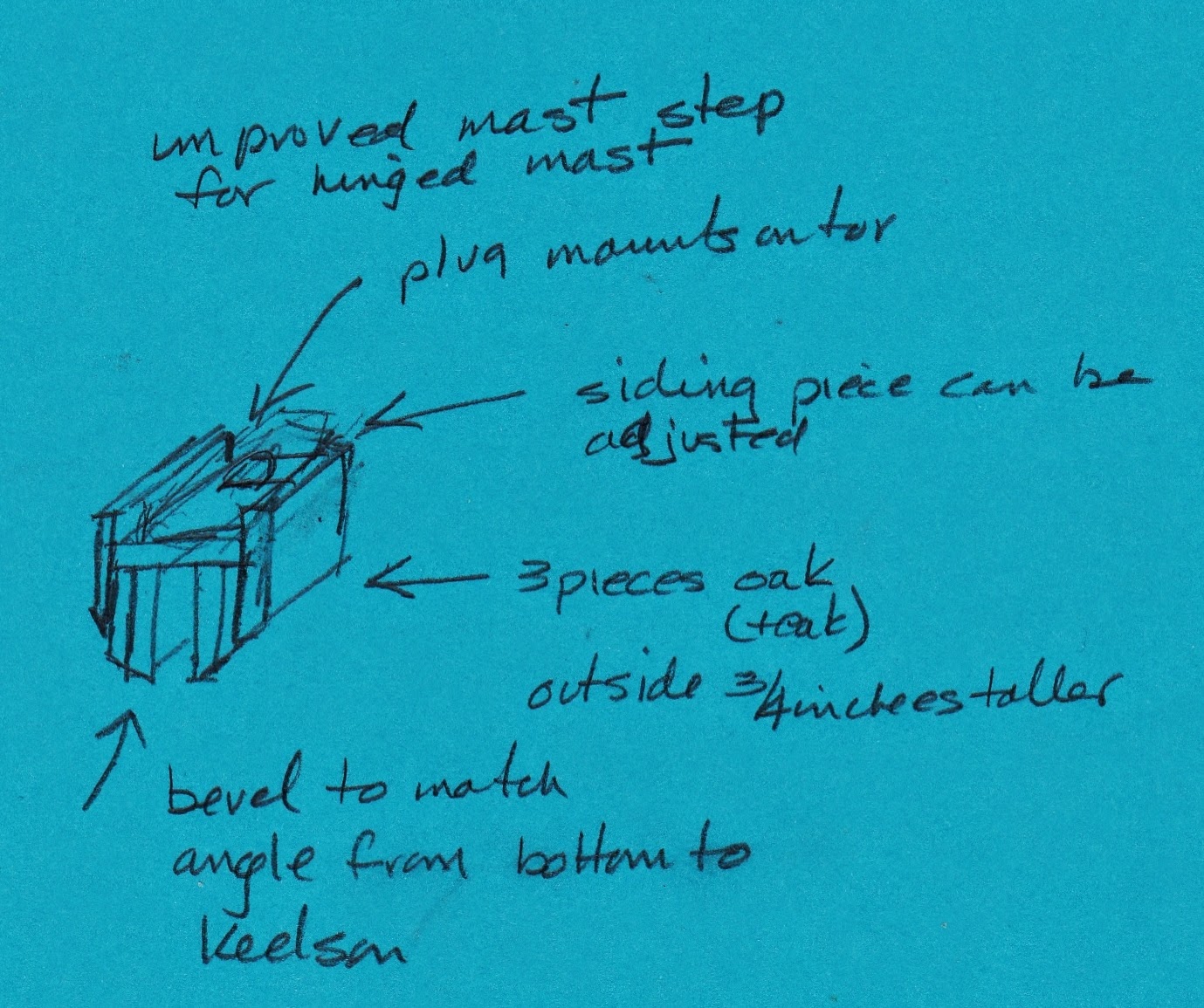Tanzer 16 Hinged Mast Retrofit -- Part 3 -- making the base for the king post -- September 8, 2014. So far we found a spare mast to experiment on, purchased a hinge, and made the plugs for the mast. Time to make the new kingpost base.
Reminder--you are seeing this as I build it. I haven't finished yet. There will undoubtedly be mistakes made along the way.
You could keep this really simple. You could just drill a hole in the mast base and bolt it into the keelson..As long as you position it so that the brace on the deck and the attachment point on the keelson are in the right place, it will probably work. That's what I intended to do. I even drilled the hole for a 1/4" stainless bolt.
 |
I didn't use a drill press, because I didn't want to make a fixture to hold
the casting, but I was very careful to make sure the hole was perpendicular
to the plane of the keelson.
|
Then it occurred to me that I would like the kingpost base to be a little more beefy. And, I wanted the ability to move it fore and aft if I made a mistake--I was not trying to make it adjustable under sail--that's a rule breaker. (Eh, probably all of this is a rule breaker. I would check with the measurer if you race in one-design fleet.)
 |
Not real precise planning, but I thought I would just climb in and out of the
boat and figure out the sizes as I went along. I did make it 11 inches long. I
decided later to leave out one piece of oak so the mast would only be
raised 3/4 of an inch.
|
To build this, you need to capture the angle between the floor and the keelson. In my boat it is about 30 degrees. I used a bevel gauge to find the angle. I cut four pieces of oak with that angle. The two inside pieces were the same height as the keelson. The outside pieces were wider. Of course it's a boat so everything is a curve. The tops have to be tapered --just lay the side piece on the bottom and hold it tight against the keelson. Then drag a pencil along the top of the keelson and cut the pieces off with a band saw.
 |
I just cut four pieces wider than I needed them and then went back to
the boat to get the height and taper to cut the top. You really can't do this
with a hand saw.
|
 |
I used a band saw to get the right taper on the top--the front is about
a 1/2" shorter than the top--the bottom rises as it nears the bow--it's a boat.
You could use a hand saw or jig saw for this operation.
|
Leave the outside ones a little taller so you can plane them to fit.
Then after some dinking around to get the width exactly right you can make a cap piece.

Everything needs to fit snugly around the keelson. Screw it together--don't glue it. The final assembly will look like this. Put polyurethane sealer on everything. You will bolt it through the keelson with 1/4 or 5/16 stainless bolts. You don't want them too low or too far forward since you will have to get a wrench on these bolts when you install the support over the keelson.
 |
| High obligue view--plug is just sitting there. |
 |
End view. Glue the two side pieces together,
but don't glue the top plate down. You
will be removing it several times before you're
through.
|
For now keep the screws in the top plate and the side plates loose. You will have to take the support out and disassemble it so that you can attach a plug once you determine the final position of the plug--and hence the angle of the kingpost to the keelson.
At least, that's How I think this is going to work when I install it. Remember; I am just making this up as I go along!
Right now the base weighs about six pounds--a lot of weight but worth it if it makes it easier to raise the mast. I will just leave the outboard at home and sit a little more toward the back.
Next up: The deck brace.
Today's Cliche: A job is what you do to make a living. Your hobby is what you do to make the job tolerable.


























